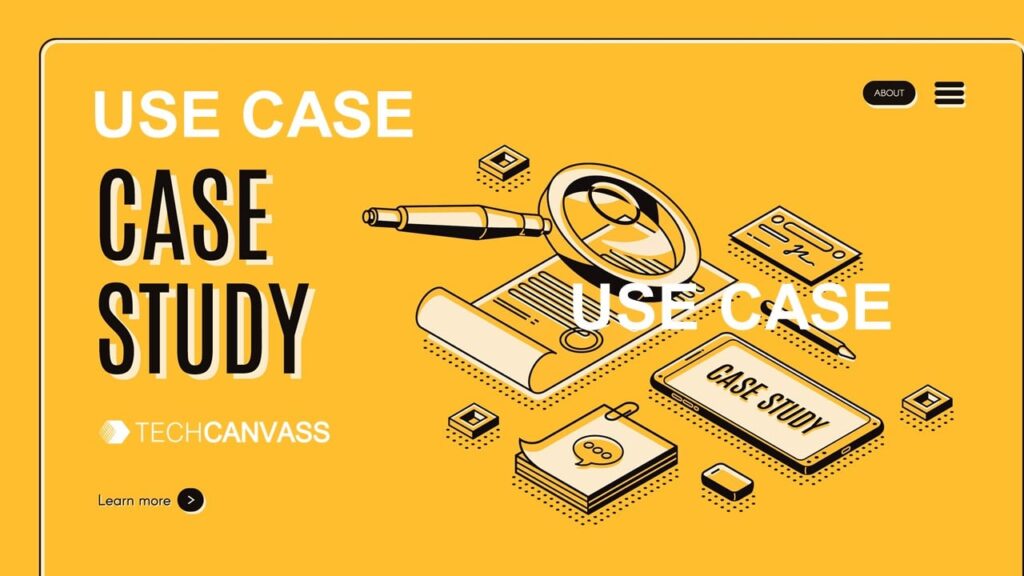Last Updated on March 14, 2024 by Techcanvass Academy
In this Use Case case study, I am going to present a case study of airport check-in system. The case study includes identification of actors, use cases and scenarios including activity diagram. I have used a generic case study approach and can be used in any software project. This case study is useful for every business analysis study.
The sequence diagram for the same case study will be covered in the some other post as that would have made this post too long.
Case study description
This proposed software system is to be designed to allow passengers to check in and get the boarding pass for flying. The baggage can also be checked-in, which is optional. The check-in can happen by the counter clerk or by the passenger using kiosk.
The system should allow individuals as well as group of passengers to check-in through the system. The boarding pass can be issued through this system. Passengers below 4 yrs need not have tickets. The airport also allows to provision for the special needs of passengers like wheelchair etc.
The system should also be able to capture the fact that the baggage for a passenger is screened by security.
Use case modelling steps
Use case modelling can be done in multiple ways. One of the standard processes is known as Rational unified process (RUP), this process is put forward by Rational Inc., now under Oracle.
In this article, I am going to suggest a process, which I used in my projects in various software companies. As per this process, the steps involved are as follows, these steps are for complete system analysis and design using UML models. However, in this article, we will look at only use case modelling steps:
- Understand the business domain, context and needs
- Conduct Stakeholder Analysis
- Interact with stakeholders to understand stakeholders needs
- The following steps are conducted iteratively:
- Find structural elements/functions – functional decomposition
- Use cases identification & Create use case model
- Identify Scenarios
- Create Activity diagrams
- Create sequence diagram, if needed
- Identify Classes and build logical data model
- System Design
- Coding
- Testing
- UAT
- Go Live
Use case modelling step 1 – Identify actors
The first step is to identify the actors from the given requirements. Actors are external entities, who interact with the system, to be developed. All the nouns used in the requirements could be actors. In our case, the possible candidates for being actors could be:
- Passenger
- Passenger with age <= 4 yrs
- Passenger with special needs
- Group of passengers
- Check-in clerk
Identification of actors is an iterative activity, where we can refine the selection of actors. If you look at the actors list, you can see that there are multiple types of passengers. This means that an actor namely Passengers has related actors. The actors can be shown as shown below:
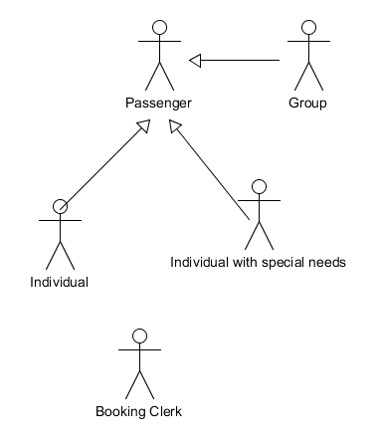
Use case modelling step 2 – Identify use cases
Once we have identified actors, we can focus on the interactions of the actors with the system. In our case of airline system, we can identify the following use cases.
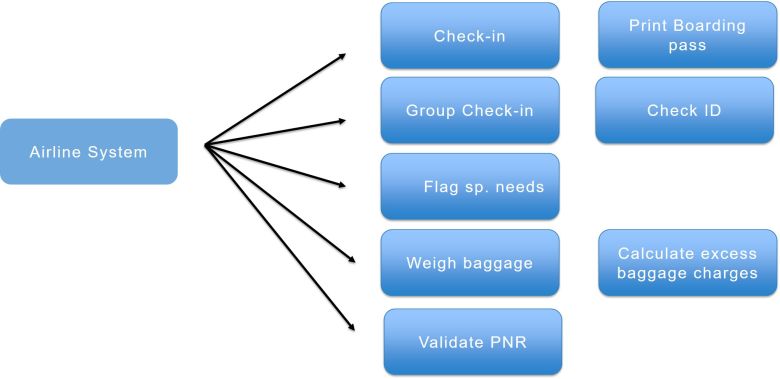
This functional mapping is an excellent way of functional decomposition as well as identification of use cases. Based on the above functional map, we can go ahead to create the use case model. A detailed use case model is as shown below:
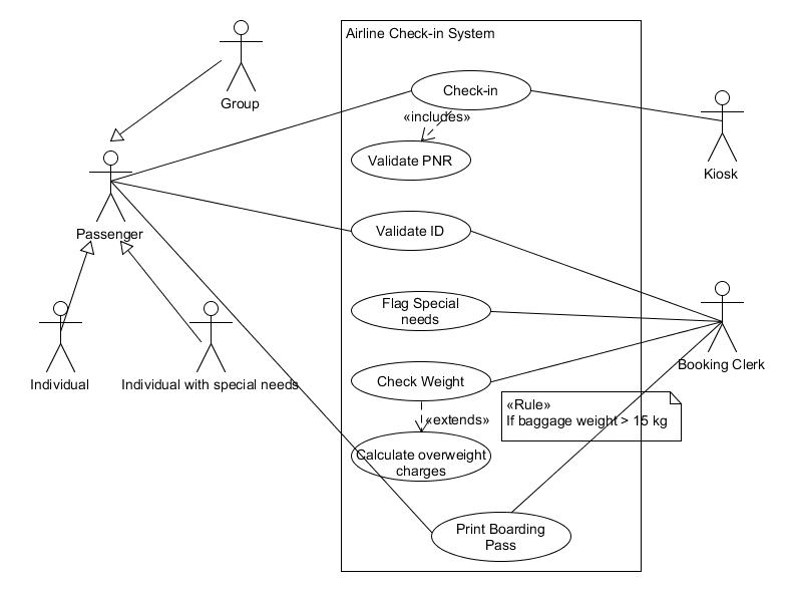
The use cases are kept within the system boundaries with proper “Include” and “Exclude” relationships. If you want to brush up your basics of Use cases and UML, you can read the following blog post:
Use case modelling step 3 – Identify Scenarios
Once we identify the use cases and build the use case model, the next step is to identify scenarios. The scenarios add details to the use case model. Scenarios also help in identifying business processes and creating activity diagrams.
Typically speaking, every use case may result in one or more scenarios. However, it’s not mandatory to make activity diagrams for each of the use cases. Every model diagram is created only if it helps in understanding the system better.
Scenarios can be of two types:
- Success scenario, when everything works fine
- Error/Alternate scenarios
Let’s see the scenarios for the check-in process.
Success Scenario: Check-in process getting completed without any issues
- Individual puts the baggage for check-in and stickers
- Shows the ticket to the booking clerk at the booking counter
- The booking clerk enters the PNR number and verifies the data
- Booking clerk asks for ID card and verifies
- The passenger puts the baggage and the weight is checked by booking clerk.
- The baggage stickers are printed and attached to the baggage
- The boarding pass is issued to the passenger
Alternate Scenario: Check-in process for Individual having special needs
- The booking clerk enters the PNR number and verifies the data
- Identify the passengers with “Special needs”
- An alert is sent to the customer service desk
There are other alternate scenarios in this case, I am not writing the steps for them. You can try that as exercise.
Alternate Scenario: Baggage weight > Allowed limit
Alternate Scenario: Valid ID card not available
Alternate Scenario: Passenger checks in using Kiosk
Having identified the scenarios, the next step is to create the activity diagram.
Use case modelling step 4 – Creating Activity diagrams
The activity diagrams can be created on the basis of identified steps and scenarios. You can use a tool to create the activity diagrams or use Microsoft Word or Powerpoint as well.
For our case study, the activity diagram is:
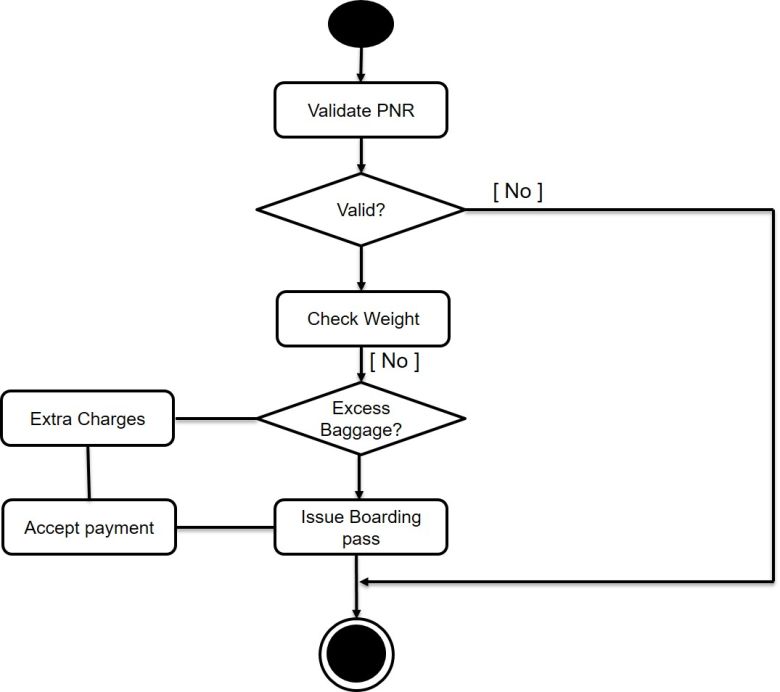
This is a type of case study, which are part of all of our business analysis courses, where we help participants to do it themselves so that you can get a hands-on experience.
Use case tools
There are many tools available in the market for creating use case models. We cover the following tools in our training programs:
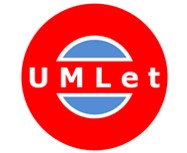
In our Business analysis courses, we discuss more case studies and projects. The ECBA Certification course is an IIBA Certification program to become a Business Analyst. Techcavass also conducts CCBA and CBAP training programs.
What’s Next
You can read our Blog article on Writing effective user stories and documents prepared by Business analysts.



